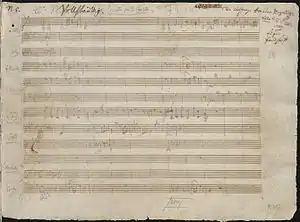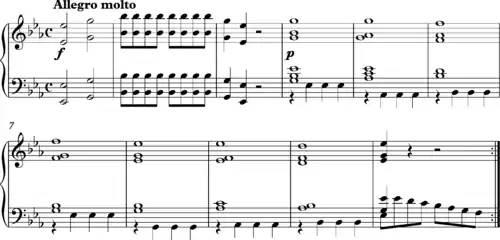Piano Concerto No. 22 (Mozart)
The Piano Concerto No. 22 in E♭ major, K. 482, is a work for piano, or fortepiano, and orchestra by Wolfgang Amadeus Mozart, composed in December 1785.
| Piano Concerto in E♭ major | |
|---|---|
| No. 22 | |
| by W. A. Mozart | |
 First page of the autograph manuscript | |
| Key | E♭ major |
| Catalogue | K. 482 |
| Genre | Concerto |
| Style | Classical period |
| Composed | December 1785 |
| Movements | Three (Allegro, Andante, Allegro) |
This is the first piano concerto of Mozart's to include clarinets in its scoring,[1] and is scored for solo piano, flute, two clarinets (in B♭), two bassoons, two horns, two trumpets, timpani (in E♭ and B♭), and strings.
Structure and analysis
The concerto is in the following three movements:
- Allegro, 4
4 - Andante (Variations) (in C minor), 3
8 - Allegro, 6
8
At about 35 minutes, it is one of Mozart's longest concertos.
Allegro
In his book on the piano concertos, Cuthbert Girdlestone pointed out the similarity between the opening of this movement and that of Mozart's Symphony No. 1, K. 16, written when he was eight years old. This juvenile work was composed for an orchestra of oboes, horns and strings. A comparison illustrates how far Mozart had developed in the intervening 20 years:
Both works start with "a vigorous and rhythmical attack and a light answer, quiet and tuneful".[2] In the earlier work, the whole ensemble plays question and answer phrases and repeats them in their entirety:

The orchestration of the piano concerto is subtler and more differentiated. In the early symphony, the answering phrase consisted of block harmonies, but in the concerto it opens out into flowing lines of counterpoint, initially featuring just two horns and a bassoon:

On repeating this, a different group of instruments plays the answering phrase, with "the unusual sound of the violins providing the bass for the solo clarinets":[3]

Roger Kamien and Naphtali Wagner have analysed in detail Mozart's use of bridge themes in the exposition of the concerto's first movement.[4] Simon Keefe has analysed the character of the dialogue between the soloist and the orchestra in the concerto's first movement.[5]
Andante (Variations)
The slow second movement is a theme and variations in C minor that recalls similar slow C minor movements in other Mozart E♭ major concertos such as K. 271 and K. 364. Mozart's father, in a famous letter to Maria ("Nannerl"), expressed surprise that a call was made for the slow movement ("a rather unusual occurrence!") to be repeated.[6]
Allegro
In the rondo finale, the main theme resembles that of Mozart's third horn concerto (K. 447). Adena Portowitz has noted similar features between the finale of the K. 271 and K. 482 concerti.[7] In another similarity to K. 271, the finale is interrupted by a lengthy and slow minuet episode before returning to the main theme for a lively finish (also recalling Count Almaviva's adagio pleadings for forgiveness leading to a buffa conclusion in Le Nozze di Figaro, a work that Mozart was working on at this time). The Andantino episode of K. 482 is melodically simpler than the parallel episode in K. 271, at least on paper, and less complex in form as well, consisting of two eight-bar phrases played by the orchestra and repeated with the solo, followed by a transition back to the rondo theme. (The Menuetto episode of K. 271, while often described as a set of variations, is actually in a more elaborate rounded binary form with both parts repeated, again followed by a transition back to the main rondo theme.) M.S. Cole has noted that the K. 482's finale marks Mozart's last use of potpourri in his compositions.[8]
References
- Thomson, Katharine (January 1976). "Mozart and Freemasonry". Music & Letters. 57 (1): 25–46. doi:10.1093/ml/LVII.1.25. JSTOR 733806.
- Girdlestone, C. M. (1948, p. 346) Mozart's Piano Concertos. London, Cassell.
- Rosen, C. (1971, p. 240) The Classical Style. London, Faber.
- Kamien, Roger; Wagner, Naphtali (Spring 1997). "Bridge Themes within a Chromaticized Voice Exchange in Mozart Expositions". Music Theory Spectrum. 19 (1): 1–12. doi:10.1525/mts.1997.19.1.02a00010. JSTOR 745996.
- Keefe, Simon P. (Summer 1999). "Dramatic Dialogue in Mozart's Viennese Piano Concertos: A Study of Competition and Cooperation in Three First Movements". The Musical Quarterly. 83 (2): 169–204. doi:10.1093/mq/83.2.169. Retrieved 2008-03-15.
- Hutchings, Arthur (1998) [1948]. A Companion to Mozart's Piano Concertos. Oxford University Press. p. 143.
- Portowitz, Adena (Winter 2001). "Art and Taste in Mozart's Sonata-Rondo Finales: Two Case Studies". The Journal of Musicology. 18 (1): 129–149. doi:10.1525/jm.2001.18.1.129. JSTOR 10.1525/jm.2001.18.1.129.
- Cole, M. S. (1974). "Mozart Rondo Finales with Changes of Meter and Tempo". Studia Musicologica Academiae Scientiarum Hungaricae. 16 (Fasc. 1/4): 25–53. doi:10.2307/901841. JSTOR 901841.
Further reading
- Steinberg, Michael, The Concerto: A Listener's Guide, Oxford (1998, ISBN 0-19-510330-0)
External links
 Media related to Piano Concerto No. 22 (Mozart) at Wikimedia Commons
Media related to Piano Concerto No. 22 (Mozart) at Wikimedia Commons- Konzert in Es KV 482: Score and critical report (in German) in the Neue Mozart-Ausgabe
- Piano Concerto No. 22: Scores at the International Music Score Library Project
- Video on YouTube, Emanuel Ax, Bavarian Radio Symphony Orchestra, Cristian Măcelaru
